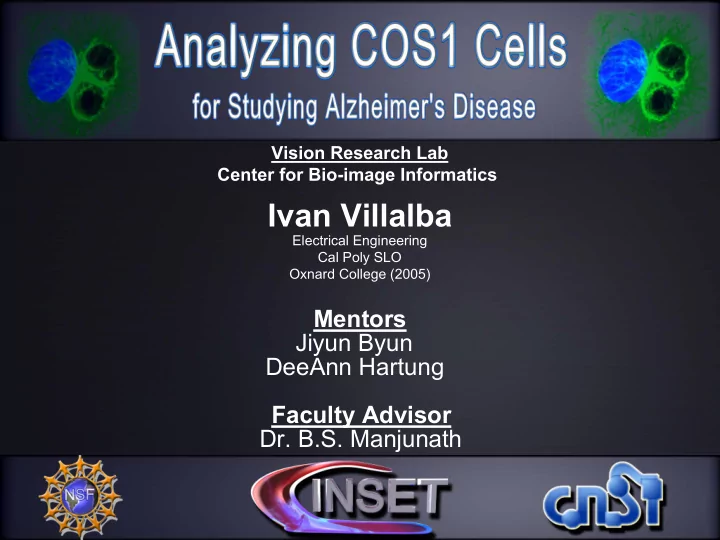

Vision Research Lab Center for Bio-image Informatics Ivan Villalba Electrical Engineering Cal Poly SLO Oxnard College (2005) Mentors Jiyun Byun DeeAnn Hartung Faculty Advisor Dr. B.S. Manjunath
• Introduction – Alzheimer’s • Image Analysis – Properties – Procedure • Experimental Results – Cell Segmentation – Cell Density • Future Work
Characterized by two pathological hallmarks in the brain, 1. Extracellular Amyloid Plagues � Amyloid-Beta (A β ) protein 2. Intracellular Neurofibrillary Tangles (NFTs) � Tau protein ? Cell Death A β Tau Alzheimer’s Dysfunction Dysfunction • Big Picture: A β and Tau – Examining molecular mechanism of cell death.
• Model System – Monkey Kidney Cells – Cancer cell line – COS1 Cells transfected with Tau • Determine cell survival/death under various treatments and time points for Alzheimer’s disease.
• Cell survival/death ratio • Cell Count by segmentation – Live cells = total cells – dead cells • Cell shape: extract further information (e.g. Cell division ratio)
120 Hours 2 Hours Various Treatments
10x Confocal microscope 1024x1024 pix 1 pix = 0.1243µm
– Total Cells – Dead Cells (Enters leaky membranes) – Live Cells (Hydrolyzed by intracellular enzymes) Hoechst Channel
• Isolate Channels Hoechst Channel
• Isolate Channels • Median Filtering – Noise Reduction Hoechst Channel
• Isolate Channels • Median Filtering • Binary Image – Threshold Hoechst Channel
• Isolate Channels • Median Filtering • Binary Image • Label Image Hoechst Channel
• Isolate Channels • Median Filtering • Binary Image • Label Image Example: 10x8 pixel Binary image
• Isolate Channels • Median Filtering 1 1 1 • Binary Image 1 1 1 1 • Label Image 1 2 2 2 2 2 2 2 2 2 2 2 2 2 2 2 2 2 Example: 2 2 10x8 pixel Label Image
• Isolate Channels • Median Filtering • Binary Image • Label Image Hoechst Channel
• Isolate Channels • Median Filtering • Binary Image • Label Image • Object Analysis
• Isolate Channels • Median Filtering • Binary Image • Label Image • Object Analysis 120 Hours Untreated
• Isolate Channels • Median Filtering • Binary Image • Label Image • Object Analysis – Normal (1 cell) 120 Hours Untreated
• Isolate Channels • Median Filtering • Binary Image • Label Image • Object Analysis – Cluster ( >= 3 cells) 120 Hours Untreated
• Object Analysis – Normal – Peanut (Dividing cell) – Cluster ( >= 3 cells)
• Area 8 1 9
• Area • Perimeter 7 1 1
4 x pi x Area • Area Compactness = Perimeter 2 • Perimeter • Compactness Normal Cluster Compactness = 1 Low Compactness
• Area • Perimeter • Compactness 3 • Minor Axis 5
• Area • Perimeter • Compactness 4 • Minor Axis • Major Axis 6
• Area • Perimeter • Compactness • Minor Axis • Major Axis • Axis Ratio Minor Axis Axis Ratio = Major Axis
Class Type: 1. Normal + Peanut 2. Cluster 2hrs Untreated
• Crop Regions 2hrs Untreated
• Crop Images 2hrs Untreated
• Area • Perimeter • Compactness • Minor Axis • Major Axis • Axis Ratio • Clusters can be discriminated. • Normal & Peanut are difficult to discriminate.
• 42 “Untreated” Images from 7 different time points • 2 hrs (7) • 6 hrs (5) • 12 hrs (6) • 24 hrs (5) • 48 hrs (8) • 72 hrs (6) • 120 hrs (5)
120 Hours Red = Normal + Peanut Green = Clusters
24 Hours Red = Normal + Peanut Green = Clusters
• Cell Density: – Cells = Number of “Normal & Peanut” – Area = Image Area – Cluster Area Cells Cell Density = Area
Cell Density (Untreated)
• Apply to various treatment – Untreated – 5 uM Staurosporine (stauro) – 10 uM Amyloid-Beta () – 100 nM Taxol (Taxol) – 100 nM Taxol + 10 uM Amyloid-Beta (Tx-) • Cell survival/death ratio.
• Better Threshold – Grayscale Image Binary Image • Improve Segmentation
Green = Peanut Red = Normal 2hrs Hoechst Channel
• Faculty Advisor – Dr. B.S. Manjunath • Mentors: – Jiyun Byun – DeeAnn Hartung • Center for Bio-Image Informatics
Characterized by two pathological hallmarks in the brain, 1. Extracellular Amyloid Plagues � Amyloid-Beta (A β ) protein 2. Intracellular Neurofibrillary Tangles (NFTs) � Tau protein ? Cell Death A β Tau Alzheimer’s Dysfunction Dysfunction
Amyloid-Beta (A β ) 1. Amyloid Percursor Protein (APP) a. Function: Undetermined 2. Can’t cause disease without Tau ? Cell Death A β Tau Alzheimer’s Dysfunction Dysfunction
Amyloid-Beta (A β )
Amyloid-Beta (A β )
Tau Protein 1. Function: Regulates neuronal microtubule dynamics
? Cell Death A β Tau Alzheimer’s Dysfunction Dysfunction
Experimental Setup • Treatments • Timepoints – Untreated – 2 hours – 5 uM Staurosporine – 6 hours – 10 uM A β – 12 hours – 100 nM Taxol – 24 hours – 100nM Taxol + – 48 hours 10 uM A β – 72 hours – 120 hours
Threshold Logical Image Pixels For Original Image Pixel Value
Threshold Logical Image Pixels For Filtered Image Pixel Value
Threshold Logical Image For For Original Filtered Image Image Pixels Pixels Pixel Value Pixel Value
Recommend
More recommend